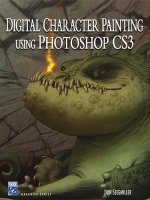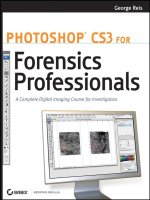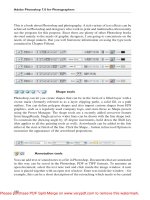Photoshop CS3 for Screen Printers doc
Bạn đang xem bản rút gọn của tài liệu. Xem và tải ngay bản đầy đủ của tài liệu tại đây (24.76 MB, 609 trang )
www.dbebooks.com - Free Books & magazines
Photoshop
®
CS3 for
Screen Printers
Joli Ballew
This page intentionally left blank.
Photoshop
®
CS3 for
Screen Printers
Joli Ballew
Wordware Publishing, Inc.
Library of Congress Cataloging-in-Publication Data
Ballew, Joli
Photoshop CS3 for screen printers / by Joli Ballew.
p. cm.
Includes index.
ISBN 978-1-59822-036-0
1. Computer graphics. 2. Adobe Photoshop. 3. Screen process
printing—Computer programs. I. Title.
T385.B35453 2007
006.6'86 dc22 2007024249
CIP
© 2008, Wordware Publishing, Inc.
All Rights Reserved
1100 Summit Avenue, Suite 102
Plano, Texas 75074
No part of this book may be reproduced in any form or by any means
without permission in writing from Wordware Publishing, Inc.
Printed in the United States of America
ISBN-10: 1-59822-036-5
ISBN 13: 978-1-59822-036-0
10987654321
0907
Adobe and Photoshop are registered trademarks of Adobe Systems Incorporated in the United States
and/or other countries.
All brand names and product names mentioned in this book are trademarks or service marks of their
respective companies. Any omission or misuse (of any kind) of service marks or trademarks should not
be regarded as intent to infringe on the property of others. The publisher recognizes and respects all
marks used by companies, manufacturers, and developers as a means to distinguish their products.
All inquiries for volume purchases of this book should be addressed to Wordware
Publishing, Inc., at the above address. Telephone inquiries may be made by
calling:
(972) 423-0090
Dedication
For my daughter, Jennifer, whose intelligence, perseverance, kindness,
and fortitude inspire everyone around her.
v
This page intentionally left blank.
Contents
Acknowledgments xix
Introduction xxi
Part I: The Photoshop Interface
Chapter 1 TheToolbox 3
TheToolbox 4
SelectingTools 5
TheAvailableTools 8
TheMarqueeTools(M) 9
The Lasso Tools (L) 10
TheCropTool(C) 10
The Spot Healing Brush, Healing Brush, Patch, and
RedEyeTools(J) 11
TheCloneStampandPatternStampTools(S) 12
TheEraserTools(E) 12
TheBlur,Sharpen,andSmudgeTools(R) 13
ThePenTools(P) 14
ThePathSelectionandDirectSelectionTools(A) 14
TheNotesTools(N) 14
TheHandTool(H) 15
TheMoveTool(V) 15
TheMagicWandandQuickSelectionTools(W) 15
TheSliceTools(K) 16
TheBrush,Pencil,andColorReplacementTools(B) 16
TheHistoryBrushTools(Y) 17
TheGradientandPaintBucketTools(G) 17
The Dodge, Burn, and Sponge Tools (O) 18
TheTypeTools(T) 18
TheShapeTools(U) 18
The Eyedropper, Color Sampler, Measure, and Count Tools (I) . 19
TheZoomTool(Z) 19
AdditionalToolsintheToolbox 20
Summary 20
vii
Chapter 2 TheMenuBar 21
File 22
Edit 23
Image 24
Layer 27
Select 28
Filter 30
Analysis 32
View 32
Window 33
Help 33
Summary 34
Chapter 3 ThePalettes 35
TheDefaultPalettes 36
Navigator,Histogram,andInfoPalettes 36
Color,Swatches,andStylesPalettes 39
Layers,Channels,andPathsPalettes 42
AdditionalPalettes 43
HistoryandActionsPalettes 43
ToolPresetsPalette 44
BrushesPalette 44
CharacterandParagraphPalettes 45
Pop-upPalettes 45
Moving,Adding,andRemovingPalettes 47
MovingthePalettes 47
TheWindowMenuOptions 47
DockingthePalettesTogether 47
TheDock 49
SavingtheWorkspace 49
PaletteTipsandTricks 49
Summary 50
Chapter 4 TheOptionsBar 51
CommonOptionsfromtheOptionsBar 52
Style 52
Mode 53
Brush 55
Opacity 58
AddingorSubtractingfromaSelectionorShape 61
ToolPresets 64
OtherCommonTermsandOptions 66
TheDock 70
Summary 70
Contents
viii
Chapter 5 PersonalizingtheWorkspace 71
RemovingItemsfromtheWorkspace 72
DockingPalettes 73
CreatingaText-basedWorkspace 73
CreatingaScreenPrintingWorkspace 75
CreatingaClient-basedWorkspace 77
CreatinganArtist’sWorkspace 78
EditingPreferences 79
UsingthePresetManager 82
SystemCalibration 85
ConfiguringColorSettings 87
MoreabouttheEditMenu 90
DefiningaBrushPreset 90
DefiningaPattern 91
Summary 92
Chapter 6 OpeningandManagingFiles 93
OpeningFiles 94
UsingFile>Open 94
UsingFile>OpenAs 97
UsingFile>Browse 98
OrganizingFiles 99
Deleting 100
Renaming 100
CreatingFolders 103
Moving 105
GettingInformationaboutaFileoranImage 106
AdditionalAdobeBridgeOptions 107
TheInterface 108
Summary 109
Part II: Creating Artwork and Logos
Chapter 7 GettingCreative 113
ComingUpwithIdeas 113
UnderstandWhattheClientWants 114
WorkingwithaClientDisk 116
BasicToolsandCommands 118
ThePaintBucketTool 118
CommonImageCommands 122
CommonEditCommands 124
ExperimentingwithBrushes 127
TheBrushTool 127
ThePencilTool 132
Contents
ix
TheHistoryBrush 133
TheArtHistoryBrush 134
UsingColorandDesignWisely 136
AbouttheImagesinThisChapter 136
WhenColorsDon’tTouch 137
WhenSpotColorsTouch 138
When Colors Blend, Process Color, Fake Process
Color, and Indexed Color 140
Summary 141
Chapter 8 UsingtheShapeTools 143
RectangleTool 143
MoreaboutRectangles 146
OptionsCommontoAllTools 147
Ellipse Tool 148
PolygonTool 148
LineTool 151
CustomShapeTool 152
Summary 156
Chapter 9 WorkingwithTextandNumbers 157
AddingText 158
UsingtheHorizontalandVerticalTypeTools 158
UsingtheTypeMaskTools 162
AdditionalOptionsfromtheOptionsBar 166
WorkingwithChinese,Japanese,andKoreanType 169
TypinginParagraphForm 170
EditingType 172
MovingType 172
ChangingFontColor,Style,andSize 172
WorkingwithMultipleTypeLayers 172
ConvertingTypetoaShape 173
RotatingType 175
FractionalCharacterWidths 176
Checking Spelling 176
RasterizingTypeLayers 177
TextPalettes 178
TheCharacterPalette 178
TheParagraphPalette 180
MoldingTexttoFitanUnderlyingShape 181
UsingtheActionsPalettetoAddTextEffects 184
WorkingwithNumbers 186
Summary 187
Contents
x
Chapter 10 Erasing 189
TheEraserTool 190
TheBackgroundEraserTool 196
WordsYou’llNeedtoKnow 196
UsingtheBackgroundEraser 198
TheMagicEraserTool 198
TheAutoEraseOption 200
TheHistoryBrushTool 202
Summary 203
Chapter 11 WorkingwithColors—AnIntroduction 205
ForegroundandBackgroundColors 206
The Eyedropper 206
TheColorSampler 209
TheInfoPalette 210
ColorModesandModels 213
RGBMode 214
CMYKMode 215
AdditionalModes 215
IntroductiontoSpotColor 216
Introduction to Indexed Color 218
IntroductiontoProcessColor 219
IntroductiontotheCurvesDialogBox 221
FinalThoughtsabouttheCurvesDialogBox 226
Summary 226
Chapter 12 LayerBasics 229
WhatAreLayers? 230
ViewingLayersintheLayersPalette 230
ChapterProject:BuildinganImageUsingLayers 233
UsingtheSelectionTools 234
CreatingBackgrounds 236
TransformingLayerImages 239
AddingText 241
IncreasingtheCanvasSize 245
Creating Edges 246
FlatteningLayers 247
PreparingforOutput 248
Summary 248
Contents
xi
Part III: Working with Client Files
Chapter 13 AcquiringFilesfromDisks 251
WhenaClientBringsaDisk 252
VirusProtection 252
ProprietaryFileFormats 253
ScannedArtwork 253
ResolutionbytheInch 254
WhattoAskFor 256
SwitchingtoRGB 257
OpeningtheFile 257
UsingFile>Open 257
UsingFile>OpenAs 258
UsingFile>OpenRecent 259
UsingFile>Import 259
WorkingwithE-mailedArtwork 259
SavingtheFile 261
AcquiringaFilefromaWorkgroup 261
FileTypesandLimitations 262
PSDFiles 263
EPSFiles 263
EPSDCS2Files 264
BMPFiles 264
TIFFFiles 264
JPEGFiles 264
GIFFiles 265
PDFFiles 265
Summary 265
Chapter 14 AcquiringFilesfromScanners 267
UnderstandingScannerTerminology 268
ConfigurationOptions 270
AbbreviationsandProperNames 271
ConfiguringtheScanner 272
SoNowWhat? 275
CreatingaCurve 275
TipsforScanningaPhotoorLineArt 277
Pixelation,FileSize,andOtherDrawbacks 280
Solutions 281
Summary 281
Chapter 15 AcquiringFilesfromDigitalCameras 283
AcquiringthePhoto 284
UsingFile>Import 284
UsingFile>Open 286
Contents
xii
UsingtheCamera’sSoftwareorYourOperatingSystem 287
Troubleshooting 288
CreatingaContactSheet 288
ResizinganImage 290
UsingFile>Scripts>ImageProcessor 291
AddingFileInformation 292
UsingFile>FileInfo 293
CreatingYourOwnDigitalCameraLibrary 295
Summary 296
Chapter 16 WorkingwithPhotosandMakingSelections 297
BasicColorCorrection 299
UsingAutomaticAdjustments 299
UsingManualAdjustments 302
UsingUnsharpMask 305
TheCurvesToolRevisited 307
SelectionswiththeMagicWandTool 310
UnderstandingtheOptionsintheOptionsBar 311
UsingtheMagicWandTool 312
Selections with the Lasso Tools 313
The Lasso Tool 314
The Magnetic Lasso Tool 317
The Polygonal Lasso Tool 319
Summary 320
Chapter 17 HeatTransfersandSublimation 321
HeatTransfers 321
HowPhotoshopPlaysaRole 322
Sublimation 324
HowPhotoshopPlaysaRole 324
Summary 326
Part IV: More Tools
Chapter 18 CloningandCorrectionTools 329
TheCloneStampTool 330
TheOptionsBar 333
Tips 334
ThePatternStampTool 334
TheOptionsBar 334
MatchingPatterns 338
Tips 340
TheHealingBrushTool 341
Tips 343
Contents
xiii
ThePatchTool 343
Summary 346
Chapter 19 WorkingwithThird-PartyClipArt 347
ObtainingClipArt 348
PurchasefromaComputerStore 349
GetClipArtFreefromtheWeb 349
ClipArtSubscriptions 351
HowtoUseClipArt 351
UsingthePlaceCommand 355
WhataboutCopyrights? 357
FreeClipArt 357
PurchasedClipArt 358
Limited-DistributionArtwork 358
Summary 359
Chapter 20 SpecialEffects 361
UsingFilters 362
ArtisticFilters 363
OtherFilters 364
Extract 370
Liquify 373
TheFadeCommand 375
BlendingModes 376
BlendingModeOptions 376
ApplyingaBlendingModetoaLayer 379
UsingtheGradientTool 381
GradientStyles 382
ApplyingaGradient 383
TipsforGoodSpecialEffects 384
Summary 384
Chapter 21 Pens,Paths,andMasks 385
UsingthePenTools 386
WhatIsaPath? 386
OptionsBarChoices 386
DrawingaPath 387
Editing(Adjusting)aPath 388
MultipleSegments,ClosedPaths,andCurves 389
Converting Paths to Selection Borders, Adding and
Subtracting Anchor Points, and Other Important Features . . . 392
WhatAreMasks? 394
UsingVectorMasks 394
UsingLayerMasks 395
Summary 397
Contents
xiv
Part V: Color Separations
Chapter 22 SpotColorSeparations 401
BuildingYourOwnDesign 402
PreparePhotoshop 403
PreparetheImage 404
AboutPantoneColors 406
AlphaChannels 407
GettingtoKnowtheChannelsPalette 408
PerformingSpotColorSeparations 409
PrintingSpotColorSeparations 417
Summary 421
Chapter 23 ProcessColorSeparations 423
BeforeStartingThisChapter 424
ChapterProjectPartI:PreparetheImage 424
CleanUptheImage 425
TextandBorders 426
ChapterProjectPartII:PerformtheSeparation 429
Chapter Project Part III: Correct Color 430
WorkingwithColors 431
ChapterProjectPartIV:AdditionalTechniques 435
CreateaSpotColorChannel 436
ViewtheFinalSeparation 439
WorkingwithVectorTypeLayers 440
AddtheType 441
ConverttoCMYKandTesttheOutput 442
IncludetheTypeinaSpotColorChannel 444
Summary 446
Chapter 24 IndexedColorSeparations 447
Indexed Color Explained 448
ChoosingYourColors 448
Zooming in on Indexing 449
Chapter Project: Perform an Indexed Color Separation 450
ChangingtheMode 451
ChoosingtheColors 451
LookingattheImage 454
CreatingChannels 455
RepeatforEachChannelandColor 457
Summary 458
Contents
xv
Chapter 25 SimulatedProcessColorSeparations 461
Preparations 462
ChapterProject:SimulatedProcessColorSeparations 463
CreateanUnderbasePlate 464
CreateaHighlightWhitePlate 465
SelecttheMainColors 467
ChoosetheRemainingColors 468
MakeaShirtColorChannel 469
DragtheUnderbaseandWhitePlatetotheOriginalFile 469
ViewinPrintOrder 470
Summary 471
Chapter 26 MoreaboutColorSeparations 473
ColorGamuts 473
RGB 474
CMYK 474
HowBasicColorsareCreatedfromProcessInks 475
OutofGamut 475
ICCProfiles 478
HalftoneScreens 479
DotGainandLoss 479
CorrectingDotGainProblems 480
SelectiveColorCorrectionTechniques 480
ColorSettings 482
UndercolorRemoval(UCR) 482
GrayComponentReplacement(GCR) 482
BlackGeneration 483
UndercolorAddition(UCA) 483
DCS2.0 483
Resolutions 486
ImageResolution 486
PrinterResolution 487
ScreenResolutionandFrequency 487
MeshCount 488
Moiré 489
PostScript 490
Summary 490
Part VI: Printing
Chapter 27 PageSetupandPrintDialogBoxes 495
ExploringthePrintDialogBox 496
PreviewingtheImage 497
Position 499
Contents
xvi
ScaledPrintSize 499
ThePrintDialogBoxOutputOptions 500
TheBackgroundButton 500
TheBorderButton 501
TheBleedButton 501
TheScreenButton 501
TheTransferButton 502
Interpolation 502
PrintingMarksOptions 503
ThePrintDialogBoxColorManagementOptions 505
ExploringthePageSetupDialogBox 507
Paper,Source,Orientation,andMore 507
ThePrintSizeCommand 508
Summary 509
Chapter 28 SpecialtyPapers 511
Vellums 511
ProblemswithVellum 512
FilmandLaserAcetate 513
InkjetFilms 513
Polyester-basedFilmforLaserPrinters 513
Capillary Direct Film 513
LaserAcetate 514
ServiceBureaus 514
Summary 515
Chapter 29 PrintingColorSeparations 517
Double-checktheColorSettings 518
PrintingTrueSpotColorSeparations 520
PrintingProcessColorSeparations 525
PreparetheImage 525
OutputtheImage 526
Printing Spot Color Separations with Tints, Gradients,
andHighlights 529
PrintingSpotColorswithGradients 529
Printing Indexed Color Separations 531
PrintingSimulatedProcessColorSeparations 533
Summary 535
Chapter 30 SpecialtyPrinting 537
PrintingHeatTransfers 538
HeatTransferPapersandInks 538
PrintingfromPhotoshop 539
PrintingSublimation 541
SublimationPapersandInks 541
Contents
xvii
PrintingfromPhotoshop 542
CADCutters 543
CADCuttingFilmsandInks 543
PrintingfromPhotoshop 543
PrintingNumbers 544
UseHeatTransfersandSublimation 544
PurchasePaperStencils 544
Employ a Stenciling System 545
UseVinylNumbers(CADCutting) 545
Summary 545
Glossary 547
Index 571
Contents
xviii
Acknowledgments
Several people made this book possible. First, thanks to the folks at
Wordware Publishing who gave me the opportunity to write the book,
including Tim McEvoy, who kept everything organized and on the right
track. In addition, technical editor David Helmsley worked diligently on
the manuscript seeking out technical errors, while editors Martha
McCuller and Beth Kohler edited for grammatical ones. It takes quite a
few people to make a book work, and I had a great team.
I’d also like to thank a few people who, over the six months and ten
hours a day I spent writing this book, sent me everything from faster
computers to software to personal tips about screen angles, halftone dot
patterns, and moiré. Thanks to James Jones at Intel for the new com-
puter, Fred Schoeller from Arts & Letters for the clip art, J.D. Burke
from Metroplex Screen for the printing tips and for generally letting me
“hang out,” Scott Fresner of the U.S. Screen Printing Institute
(www.screenprinters.net) for FastFilms, and Cosmo at North Texas
Graphics (www.NorthTexasGraphics.com) for letting me try out my test
screens on your presses. I also have a wonderful agent, Neil Salkind, who
at every turn is encouraging and positive and always available when I
need him.
A group thanks to all the people who answered my questions on the
screen printer’s e-list () and spent
their personal time answering queries and giving advice. You were great!
Of course, without the support of my family, I’d never have had the
time to write a book like this. I have the most supportive and encourag
-
ing family in the world, and I love them very much.
xix
This page intentionally left blank.
Introduction
There are between 20,000 and 30,000 registered screen printing compa
-
nies in the U.S. and many thousands more worldwide. Additionally, there
are thousands of companies that are run from backyards, garages, and
storage facilities. All of these screen printing companies have one thing
in common—they all use some type of graphics program to create art
-
work, work with client files, and print out specialty prints and color
separations for their film and screens. Many of these artists use some
version of Photoshop; unfortunately, there isn’t a single book available on
the subject…until now!
This book details how to use Photoshop CS3 in a screen printing
company. Screen printers have different needs than offset print facilities,
advertising companies, artists, photographers, or web designers, and
most books on Photoshop don’t address these needs. As you know, most
Photoshop users don’t need a thorough explanation of four-color separa-
tions and how to print them on PostScript printers, but screen printers
certainly do; in fact, it is the heart of the process.
In this book I’ve made certain assumptions, such as you either have
a working screen print facility or are just starting one, you have a work-
ing knowledge of computers, and you have Photoshop CS3 installed or
will install it soon.
The Book’s Unique Features
This book consists of six sections. Part I is written for those new to
Photoshop and details the toolbox, the menu bar, the palettes, the options
bar, personalizing the workspace, and how to open and manage files.
Even if you use another version of Photoshop, you’ll find that this section
is informative and a must-read. Part II covers creating artwork and logos.
It starts with basic tasks like coming up with ideas and ends with building
a complex image from scratch using layers. Part III is all about working
with client files and includes information on opening, importing, scan
-
ning, and working with client-created artwork. You also learn how to
create artwork for sublimation, heat transfers, and similar substrates.
xxi
Part IV details some of my favorite tools, how to work with third-party
clip art, and how to add special effects.
Part V, the heart of the book, explains how to perform all kinds of
color separations, including spot color, process color, indexed color, and
simulated process color. This is invaluable information for any screen
printer. Finally, in Part VI, I cover how to print all of these separations
and include everything you need to know about screen angles, line count,
dot gain, halftone dot patterns, and more.
In addition to these topics, the chapters cover the following screen
printing-specific tasks:
n
Using Adobe Bridge to open and manage files
n
Personalizing the workspace for optimum screen printing
applications
n
Adding shapes, text, and colors for logo creation best suited to
screen printing (one to four colors)
n
Editing photos for more successful heat transfers
n
Using paths and vector masks to create logos and designs
n
Working with text and numbers
n
Using the eraser tools
n
Understanding color models and color modes
n
Working with e-mailed files
n
Understanding file types
n
Working with digital cameras, scanners, and various disks
n
Using the Magic Wand, Lasso, Clone Stamp, and Pattern Stamp tools,
and more
The CD
This book includes a companion CD. The CD contains logo designs that
can be used as templates for your own work, some sample artwork and
photos that contain layers, and samples of logos and designs that incorpo
-
rate applying filters and other special effects. In addition, almost every
chapter has exercises and chapter projects. The files that you need to
work through these projects are on the companion CD.
Introduction
xxii
And Finally….
I hope you find this book informative and useful. I’ve tried to incorporate
all you need to know to get started with Photoshop, create artwork, per
-
form color separations, and print them successfully. I’ve consulted many
print shops (including my own, of course!) and fused all of the sugges
-
tions, tips, and tricks together in this book.
I can be reached at , and I look forward to
hearing from you!
Introduction
xxiii
This page intentionally left blank.









